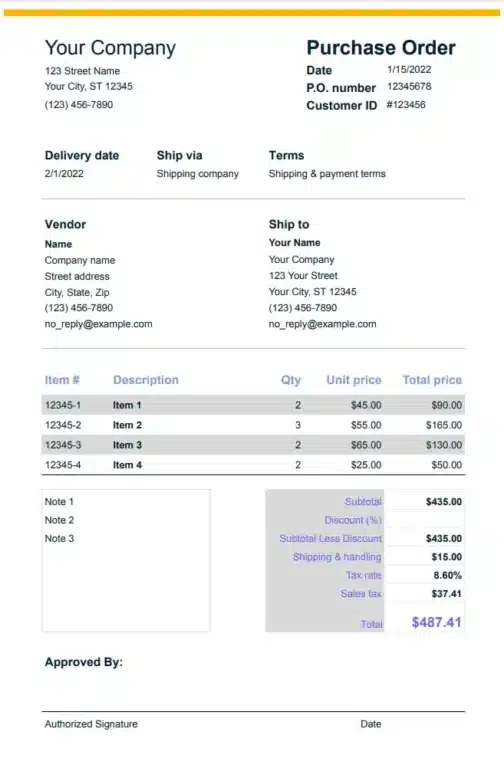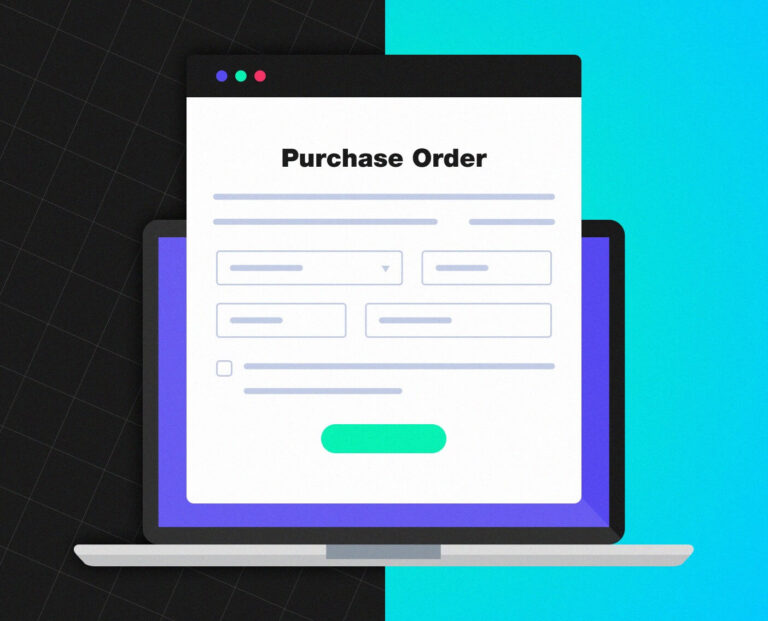Let’s talk about purchase order creation.
Buying goods and services for yourself is pretty simple, both for you as the buyer and for the vendor. You know what you need, when you need it, what the allocated budget is, etc. You can source the product or service from the right vendor and simply buy it. For the vendor, it’s simple, too – providing what you need, charging you for it, and you both live happily ever after.
When businesses or organizations buy things, it isn’t as simple and requires approved purchase orders. Firstly, establishing a need, getting approvals, and dealing with payments are often handled by different people, with time and gaps between interactions often resulting in communication issues and data loss. Secondly, payments themselves can have issues if invoices are addressed to the wrong entity or if the wrong vendor bank account is inserted into the system. On top of that, businesses need a clear audit log of what specific steps led to money getting spent – who did what, when, and why. Not only does this prevent misconduct and (in nightmare situations) fraud, but it also helps companies have legal protection, achieve certifications, and go through successful mergers and acquisitions. Even going public requires a proper audit log.
However, with the right practices and purchasing software for procurement, it is possible to overcome the challenges of business procurement vs. purchasing, and purchase orders are key. Let’s dive into the PO process; learn what POs are, how POs work, as well as how and where POs are created. In short, in just a few minutes, you’ll be up to PO speed!
What is a Purchase Order?
A purchase order (PO) is a legal document sent from the buyer to the vendor, which authorizes a purchase of goods or services. It is created after a PO request, or purchase request is submitted and approved. The purchase order details what’s being purchased, for what amount, in what quantity, and also expected dates (or time frame) and place (or places) of delivery. The PO document is legally binding, but more importantly, it helps both sides of the transaction log, deliver, and streamline the purchase.
Who creates a purchase order? A purchase order is created by the buyer after the purchase request is approved. It is then sent to the vendor or supplier.
There are 4 different types of purchase orders:
- Standard purchase orders – these are the most common POs, and they reflect a situation in which the buyer knows exactly what they’re buying, the cost, quantity, delivery date, and place.
- Planned purchase orders – these are used when the buyer knows what they are buying and for what cost (per item), but the quantity and delivery date are still unclear, and, therefore, it may use an estimated quantity and delivery schedule.
- Blanket purchase orders – these can be used to negotiate better pricing or secure stock and delivery dates in advance. Planned POs and blanket POs are often used interchangeably, for example, in the case of consultants, law firms, etc.
- Contract purchase orders – basically, this is a standard purchase order with a signature page, which is sometimes used by large enterprises that look to be extra safe. You won’t typically come across many of these.
Let’s focus on standard purchase orders for now.
Steps to Creating a Purchase Order
- The purchase is approved on the buyer’s side
If the business deploys a proper procurement process, the purchase order creation should be the result of a purchase request (or requisition) going through an approval process. The approval process will usually start with the requester’s manager, and depending on the purchase’s amount, type, and sensitivity, may require additional approval from other stakeholders (budget owners, legal, security, and finance teams). - The buyer sends the vendor the purchase order
Once the purchase order creation is done, the buyer sends it to the vendor either via email or automatically using the business’s PO or ERP system. The vendor should acknowledge receipt of the PO so that the business knows everything is on track. Supplier acceptance of a purchase order creates a legally binding contract. - The vendor fulfills the order
The vendor should now supply the goods or services according to the details listed in the purchase order. At this stage, the vendor in your supply chain will send the buyer the invoice, which reflects the PO. Usually, the business would mark ‘Goods Received’ on the purchase order’s line items, which will later be used by the business’s AP department for what’s called ‘three-way matching’ to detect invoice discrepancies. - The buyer pays the vendor’s invoice
The business processes the invoice, and pays the vendor based on the payment terms, which are also dictated and listed on the purchase order.
Create purchase orders accurately and efficiently.
Procurement automation automatically creates PO forms from requisitions.
Important Purchase Order Information
Creating a purchase order will usually be conducted over a digital system, which either contains or automatically generates most of the purchase order’s information. Using digital systems is the only way to really scale procurement process operations, and without it, a business will quickly get lost in piles of unorganized papers. A digital system gives your company effective purchase order management and visibility into cash flow requirements.
A purchase order needs to contain the following information:
- Purchase order date
- Purchase order number (PO number) – this is a unique, sequential number that allows both sides to easily find and log the PO in the purchase order system
- Buyer details – formal name, billing address, and shipping address
- Vendor details – formal company name and address, contact information is often added
- Shipping address – the address to where the goods will be shipped. If a service is covered in the PO, this will be the buyer’s address
- Shipping terms and payment terms for the accounts payable invoice
- Line items – list of items which include their
- Item name
- Item ID
- Item description
- Quantity
- Discount
- Unit price
- Subtotal – total cost, including shipping cost, minus discounts. Tax is added, if applied
Sample Purchase Order Template
Although your business will be using ERP or procurement automation software to create digital purchase orders, we include a standard purchase order example in this article. The purchase order template illustrates a business PO for purchasing, including the purchase order information described above. The PO form also contains an expected delivery date and lines for procurement management adding approval signature(s) and the PO approval date.

Methods to Create a PO Using Accounting, ERP, or PO Systems
Purchase orders and purchase order management are important to both businesses and their vendors. They help streamline the enterprise procurement process, add a layer of assurance to the transaction, help both sides stay organized, and deal with challenges. So now that you’ve decided to start a purchase order process, where should start your purchase order creation?
Word doc or PDF – using one of the widely available templates, you can customize your own PO and start sending them right away. However, it may become challenging to deploy the other parts of the PO process, such as requisition approvals, invoice matching, and generally keeping everything organized. Avoid using human error-prone Excel spreadsheets.
Accounting tools – some accounting software like QuickBooks can be leveraged to generate purchase orders. Creating POs in QuickBooks is a good option if you’re a small business looking to introduce some order into your purchasing, but for larger organizations, it likely won’t scale.
ERP – enterprise resource planning software always comes with a PO module which can be leveraged to create POs. Generating POs on the ERP, as you do other important financial processes, is good practice. However, ERPs are often technical and complex, making the purchase approval and ‘goods received’ steps of the process hard on employees.
Purpose-built PO tools – these systems use the best of both worlds; they have a simple interface for users to create purchase requests, for approvers to approve those requests, and upon approval, they create purchase orders which can be configured to be sent automatically to the vendor. Some PO tools and AP automation software offer additional financial capabilities like invoice and payment automation. All of these features help make the purchase approval process more friction-free.
Any business can recognize the true value in purchase orders. This important documentation created in the purchase order process helps both businesses and their vendors stay on top of their procurement processes, close any time or money-wasting gaps, and work better together.
Interested in implementing a spend management system that simplifies and streamlines your business’s existing process? Check out Tipalti Procurement and request a free demo today!
FAQs
What is a purchase order?
A purchase order is an official, binding document created and sent by the buyer to the seller. It includes the items being purchased, the quantity, pricing, expected delivery date, etc. The seller uses it to fulfill the order, and once sent and received by the buyer, it is compared against the invoice and goods received note to issue payment and close the purchase.
Why is a PO created?
A PO or purchase order is created to provide the seller (the selected vendor or supplier) an official document listing the information needed to fulfill the order. After the order is fulfilled, it is used to match to the invoice and goods received note in order to issue payment, and it is important for record-keeping and auditing purposes.
Who should create a purchase order?
The buyer should create the purchase order form. The buyer, also known in the procurement process as the purchase requestor, will create a purchase order once the purchase request is approved. The buyer then sends the purchase order to the supplier (seller) so that they can accurately fulfill the purchase.
Automating the Purchase Order Creation Process
Tipalti Procurement automates the electronic purchase order creation process, using a modern purchasing process with best practices that save money. With Tipalti Procurement, your business digitally creates the PO from the approved purchase requisition details. You’ll have better purchase order management and business spend management.
Procurement automation streamlines workflows and automates procurement processes to increase efficiency. Tipalti Procurement increases the accuracy of information, including self-service supplier onboarding with their secure contact and payment data. The Tipalti automation software provides an audit trail, strengthens controls, and reduces fraud risk. Explore more about technology-powered procurement best practices in this webinar.

